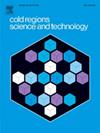Mechanical modeling for precast trapezoidal canal under the influence of bi-directional frost heave and field experimental verification
IF 3.8
2区 工程技术
Q1 ENGINEERING, CIVIL
引用次数: 0
Abstract
Precast lined canals are important water conveyance structures; however, they often suffer severe frost heave hazardous in cold regions. Currently, the frost heave design of precast canallining canals mostly depends on engineering experience, and the analytical mechanical model under the frost heave action of foundation soil is seldom studied, which leads to a deficiency in existing design. First, the frost heave characteristics of the canal are analyzed, and the canal lining structure is regarded as simply supported beam. Then, the frost heave mechanical model of precast lining canal under bi-directional frost heave is established, and the bending moment and deflection are deduced. The accuracy of the model is verified by comparing with field monitoring test data. Finally, the frost heave law of the precast lining canal is revealed by parameter analysis. The results show that the bi-directional frost heave calculation method should be employed in shallow ground water, while the ordinary frost heave calculation method can be selected for deep ground water. The maximum displacement at the joint of the precast lining is 2.42 cm, less than 3 cm permissible displacement, whereas that of the cast lining is 1.65 cm, which is 46.67 % higher than that of the cast plate, the frost heave displacement of the cast-in-place plate is greater than 1 cm. This clearly demonstrates the superior deformation capacity and frost resistance. The research results can provide a theoretical basis for frost heave design of precast lining canals in cold regions.
求助全文
约1分钟内获得全文
求助全文
来源期刊

Cold Regions Science and Technology
工程技术-地球科学综合
CiteScore
7.40
自引率
12.20%
发文量
209
审稿时长
4.9 months
期刊介绍:
Cold Regions Science and Technology is an international journal dealing with the science and technical problems of cold environments in both the polar regions and more temperate locations. It includes fundamental aspects of cryospheric sciences which have applications for cold regions problems as well as engineering topics which relate to the cryosphere.
Emphasis is given to applied science with broad coverage of the physical and mechanical aspects of ice (including glaciers and sea ice), snow and snow avalanches, ice-water systems, ice-bonded soils and permafrost.
Relevant aspects of Earth science, materials science, offshore and river ice engineering are also of primary interest. These include icing of ships and structures as well as trafficability in cold environments. Technological advances for cold regions in research, development, and engineering practice are relevant to the journal. Theoretical papers must include a detailed discussion of the potential application of the theory to address cold regions problems. The journal serves a wide range of specialists, providing a medium for interdisciplinary communication and a convenient source of reference.
 求助内容:
求助内容: 应助结果提醒方式:
应助结果提醒方式:


